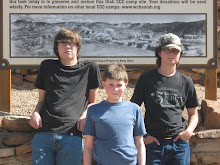Note: I will be quoting a thread from Dinosaur Home quite often in this post, so here’s the link to it:http://www.dinosaurhome.com/a-simple-question-on-t-rex.-based-on-fossil-evidence.-has-an…-128402.html#17621
To begin, I’d like to indicate that in the above thread, the possibility of large Late Cretaceous theropods hunting sauropods has been brought up by a couple people. Now I’d like to quote tzavecz, who is one of the many people discussing this fascinating topic (All quotes I make are from the above link).
“There a paper less than six years old on a Titanosaurid from Northen Mexico that was about the same time frame. [85 million years ago]”
I think what tzavecz is referring to here is the Alamosaurus, which was a large sauropod that lived in New Mexico during the Late Cretaceous.
http://en.wikipedia.org/wiki/Alamosaurus
*Note: I know that some people believe Wikipedia to be unreliable, so I think it’s worth mentioning that I’m only using it to validate the existence of Alamosaurus, not to state any facts about it.
Though not a Late Jurassic sauropod, Alamosaurus was very large, probably reaching lengths near to or exceeding the lengths of the Jurassic Giants. The beast probably lived in large herds as most other herbivorous dinosaurs (especially sauropods) did. Now, during the Late Jurassic, theropods such as Allosaurus would often hunt in packs to take down a weak, old, young, or sick sauropod; they would do this by separating the animal from the rest of the herd, then moving in for the kill. And the kill would feed all individuals for a decent period of time.
In the case of Alamosaurus, one large predator lived alongside it, one of the most notorious dinosaurs known: Tyrannosaurus rex. T. rex specimens have been found as far north as Canada and as far south as New Mexico, so my guess is that these two creatures (Alamosaurus and Tyrannosaurus) did often encounter each other physically from time to time. And it is entirely possible that, on occasion, rexes would get together to hunt an individual Alamosaurus just as the Allosaurus did millions of years before them.
But the link stops there. To my knowledge, no large sauropods dating back to the Late Cretaceous have been found north of New Mexico (somebody correct me if I’m wrong here…). Now I’d like to quote HitBear:
“They’d have to take down a lot more prey to feed such a large group, and the hit / miss ratio for preditors has always been very high in favour of misses.”
The largest dinosaurs available to the majority of large predators during the Late Cretaceous were the hadrosaurs, commonly referred to as the “duckbill dinosaurs” for their characteristic mouth that resembles a duck’s bill.
Backing up for a second, it was also mentioned in the thread that Barnum Brown discovered 22 individual Albertosaurus in the same location. Brown’s find included one old individual, eight adults, seven sub-adults, and six juveniles. This find was unlike the La Brea tar pits in California and the Cleveland-Lloyd Dinosaur Quarry in Utah; there was no particular reason for these individuals to be together, other than (allegedly) the possibility that they were a pack of Albertosaurus. We’ll refer to this discovery often in the rest of this post, so bear that in mind. (to learn more about this find, visit http://www.nceas.ucsb.edu/jai/podcast_publications/inouye_science_dinosaur.pdf)
Going back to the hadrosaurs and relating it to the group of 22 Albertosaurus, it would take a lot of time and effort to kill enough hadrosaurs to feed such a large group. Theoretically, it is possible; realistically, it’s unlikely. As HitBear said, the hit/miss ratio is simply too high and the food supply is simply too low.
But there’s still the matter of why those 22 Albertosaurus were found together. Some scientists say that external factors such as floods or fires brought them together. But why were no other dinosaurs or animals found at the site; why only the Albertosaurus? Surely if a natural disaster were the explanation, other animals would be present? Whatever the reason for their being together is, it’s a potential piece to the puzzle of the predatory behavior of large Late Cretaceous theropods.
What of the matter of even larger theropods, such as Tyrannosaurus? It’d take even more time and effort to kill enough hadrosaurs to feed a large T. rex pack, especially if it consisted of 22 individuals as did the Albertosaurus discovery. Theoretically, rexes in New Mexico could work together in packs to take down Alamosaurus, but what of the other areas, where there were no extremely large herbivores that T. rex could prey upon? Loops right back to the hadrosaur issue, doesn’t it?
I’m not saying that it was impossible for large Late Cretaceous theropods to successfully live in large packs, nor am I saying that they definitely did it. I’m simply stating the facts and my personal opinions/theories on these facts. Personally, I believe there’s validity to both sides of this debate, and I find it difficult to pick a side. Based on the data I’ve seen, my personal conclusion is that, although it is possible that these large Late Cretaceous theropods hunted in packs, it is highly unlikely that they did so on a regular basis.
I hope this post was educational and helpful. If there’s anything I missed, or if you have any questions/comments you’d like to make, feel free to leave a comment below.
Friday, June 15, 2012
Subscribe to:
Post Comments (Atom)

No comments:
Post a Comment